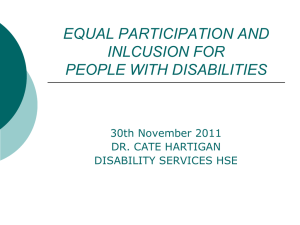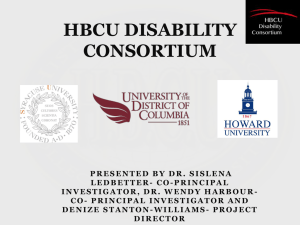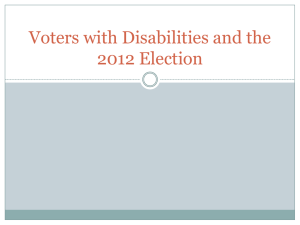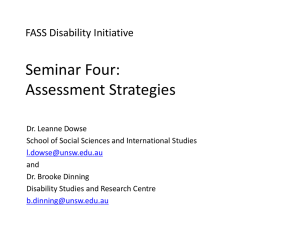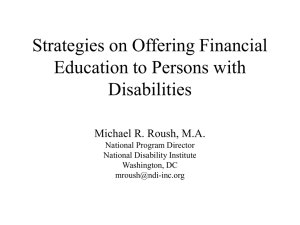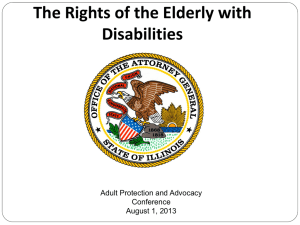Disability Awareness Training for VITA Volunteers
advertisement
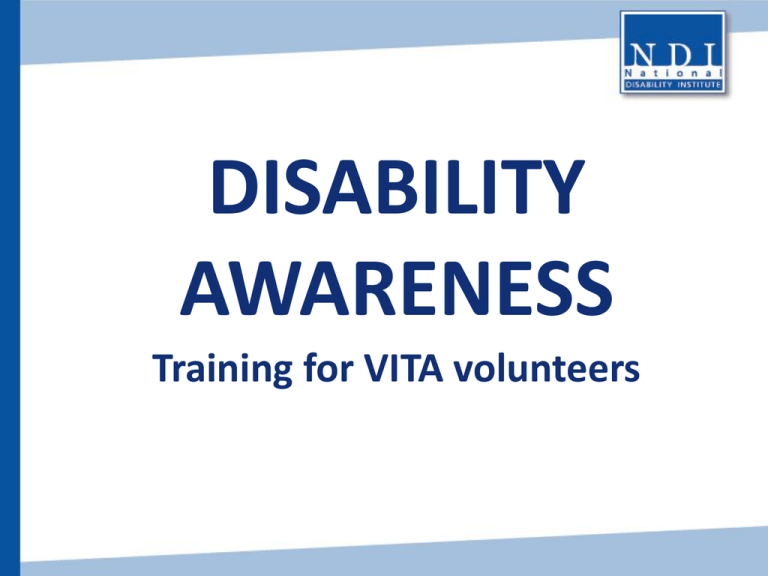
DISABILITY AWARENESS Training for VITA volunteers Agenda • • • • • • • What is disability Different types of disabilities People First Language Tips for Communicating Service Animals Policies and Procedures Site Coordinator Training • Site Accessibility Why You Are Receiving Disability Awareness Training (Coalition Name) is a part of National Disability Institute’s Real Economic Impact Network with over 900 partners in 100 cities that are working to build inclusive communities of practice and increase outreach to persons with disabilities. www.realeconomicimpact.org Disability Awareness Training • Provides information that will allow you to interact more effectively with people with disabilities. • Provides basic tips on interacting with persons with disabilities. • Eliminates myths and increases awareness of a growing demographic we serve in VITA Sites. Who has a disability? What is disability? The American with Disabilities Act (ADA) Definition of Disability: An individual with a disability is a person who • Has a physical or mental impairment that substantially limits one or more major life activities • Has a record of such an impairment or • Is regarded as having such an impairment Different Types of Disabilities Hearing Mobility Cognitive Visual Speech / Communication Learning Mental Health / Emotional Health Conditions More in common than not! Something we all have in common Any one of us could become a part of this demographic at any given moment. • Statistics In the last 10 minutes, 498 Americans became a person with a disability National Safety Council, Injury Facts 2008 Ed. • 58 million Americans with disabilities…..1 in 5 (20% of the population) • 20 million families have at least one (1) member with a disability • 51% of taxpayers with disabilities earn less than $21,000 a year PITY or PEDESTAL? Go back to the GOLDEN RULE Treat Others as You would like to be Treated! NEITHER Stereotypes Assumptions that are made about a person or group’s character or attributes, based on a general image of a particular group of people. Do not get swept up in Stereotypes Aaron Fotheringham, Extreme Wheelchair Sportsman www.aaronfotheringham.com • Persons with disabilities are all ages, come from diverse cultures and financial backgrounds. • People with disabilities work • They have families • Not all persons with disabilities are on or receive benefits such as SSI, Medicaid etc. • They have goals and dreams • All people with disabilities do not necessarily want or need assistance Other common stereotypes…. • People who are blind or have low vision may wear glasses • People who are deaf may have excellent speech and read lips but not all • Not all people that use wheelchairs are completely paralyzed – some may transfer or be able to walk short distances • Delayed or slow speech is not necessarily a sign of a slowed mental process • Persons with learning disabilities can be highly intelligent individuals they simply have a different way of learning TIPS ON INTERACTING WITH PERSONS WITH DISABILITIES People First Language “People-first” language helps us remember that people are unique individuals and that their abilities or disabilities are only part of who they are. When speaking about people with disabilities the rule of thumb is to always think about putting the person first. Examples of People First Positive Negative Accessible or Barrier Free (such as parking or entrances, seating, restrooms etc) Handicapped Person who is hard of hearing Partially Deaf, Hearing Impaired Person who has low vision Partially Blind, Vision Impaired Wheelchair User Wheelchair Bound People or Person with Disability Handicapped, the disabled, physically challenged, crippled etc Person with a developmental/ intellectual disability Retarded, mentally defective, mongoloid Born with a disability. Birth defect # 1 Tip for Communication Ask FIRST Tips in General Offer to shake hands when introduced. People with limited hand use or an artificial limb can usually shake hands and offering the left hand is an acceptable greeting Treat adults as adults! Address people with disabilities by their first names only when extending that same familiarity to all others. ASK FIRST - If you offer assistance, (always ask before assisting someone), then wait until the offer is accepted. Then ask the individual with a disability for instructions on how you may assist them. RELAX. Don’t be embarrassed if you happen to use common expressions such as “see you later” or “Did you hear about this?” that seem to relate to a person’s disability. Tips for Communicating with Individuals who are Blind or have Low Vision • When approaching state clearly who you are, speaking in a normal tone of voice. Do not shout • When conversing in a group, remember to identify yourself and the person to whom you are speaking. • Tell the individual when you are leaving • Do not attempt to lead an individual without first asking; if they choose to do so, allow the person to hold your arm/elbow • Be descriptive and specific when giving directions For example if steps, mention how many and location such as left or right • If you are offering a seat, either give verbal cues or if acting as a guide gently place the individual’s hand on the back or arm of the chair so that the person can locate their seat. Tips for Communicating with Individuals who are Deaf or Hard of Hearing • Gain the person’s attention before starting a conversation (i.e. gently wave your hand in their line of vision or tap the person gently on the shoulder or arm) • If the individual uses a sign language interpreter, speak directly to the person, not the interpreter • Know that some people who are deaf speak quite clearly and then others are non-verbal • When speaking with someone who reads lips, look directly at the individual, face the light, speak clearly, in a normal tone of voice and keep your hands away from your face. Avoid smoking or chewing gum. Tips for Communicating with Individuals with Limited Mobility • If possible, put yourself at the wheelchair user’s eye level. (especially if speaking to a person for more than a few minutes) • Do not lean on a wheelchair or any other assistive device • Never patronize people who use wheelchairs by patting them on the head or shoulder • Do not assume the individual wants to be pushed – ASK FIRST • When assisting in going up or down a curb, ask if he or she prefers going forward or backward. When pushing a wheelchair and entering an elevator, enter and turn the person around to face the opening doors (not facing a wall) • OFFER assistance if the individual appears to be having difficult opening a door • Do not take mobility aids away from users unless they request it or it is required for safety reasons. If it is necessary let the user know exactly where there equipment is being placed. Tips for Communicating with Individuals with Speech Impairments • If you do not understand something the individual says, do not pretend that you do. Ask the individual to repeat what he or she said and then repeat it back. • Be patient and concentrate on what the individual is saying. Take as much time as necessary • Do not speak for the individual or attempt to finish her or his sentences. • If you are having difficulty understanding the individual, consider writing as an alternative means of communicating, but first ask the individual if this is acceptable and only as a last resort Tips for Communicating with Individuals with Intellectual Disabilities • If you are in a public area with many distractions, consider moving to a quiet or private location. • Speak to the individual directly in simple to understand components without being patronizing and in a normal tone of voice. • Be prepared to repeat what you say, orally or in writing. • OFFER assistance completing forms or understanding written instructions and provide extra time for decision-making. Wait for the individual to accept the offer of assistance, do not over-assist or be patronizing. SERVICE ANIMALS TRUE or FALSE? All service animals must be allowed in all places of business with their owners. TRUE All service animals wear official identification such as a vest. FALSE It is required for a service animal to have an ID card FALSE There is never a reason to evict or deny access to a service animal. FALSE Definition of a Service Animal Any dog that is individually trained to perform tasks for people with disabilities. Such as guiding people who are blind, alerting people who are deaf, pulling wheelchairs, alerting and protecting a person who is having a seizure or performing other special tasks. Service animals are working animals, not pets. Do…… • Do expect that the animal is to be kept under control by the handler at all times. A handler cannot be asked to remove his or her service animal unless – the animal is out of control and the owner does not take effective control (example excessive barking) or – animal poses a direct threat to health or safety of others. • Do allow service animals into all public establishments • May ask the person if they have a disability, if an animal is a service animal or ask how the animal assists the individual but cannot require special ID cards (certification) for the animal or ask specifics about the person’s disability. DON’T……. • • • • • • • • • Don’t ask the person what their disability is Don’t ask the person to demonstrate the animal’s tasks Don’t ask for “proof” of disability or training. Don’t pet or talk to the animal without asking the owner first, because it may distract the animal or harm the individual Don’t feed the animal, many are on strict diets Don’t assume the animal will bite, service animals are selected for proper temperament and have been through many hours of training and socialization Don’t assume the individual is blind, many individuals have “invisible” disabilities such as epilepsy, heart conditions, etc. Don’t charge extra fees, isolate from other patrons or treat them less favorably. Don’t think you are required to provide care or food for a service animal or provide special location to relieve itself (Example cannot ask or expect you to walk their dog outside) SITE COORDINATOR TRAINING Policies and Procedures What are the policies & procedures for serving people with disabilities at your VITA site? Examples: How do you process an accommodation request from a customer with a disability? What are the site’s accessible features and customer service practices? Reasonable modifications are acceptable Examples: Service Animals Food and Drink Extended Appointment Time Alternate Signature Tips on Site Accessibility Site Accessibility is everyone’s mission! In order to ensure continued accessibility it is important everyone is aware of common barriers to avoid on a day to day basis. Auxiliary Aids & Services “Auxiliary aids and services” are devices or services that enable effective communication for people with disabilities. Effective Communication When a person with a disability requests an auxiliary aid or service: Consult with the individual about their choice of aid or service. Businesses cannot charge the person for the communication aids or services provided. Accessible Parking You may have accessible parking available however are your access lanes and curb cuts clear of possible debris and other barriers Facility Access: Building Entrance If there are stairs at the main entrance… Where is the ramp or lift, or other alternative accessible entrance? Where are the signs indicating the location of the nearest accessible entrance? Facility Access: Accessible Route Is the route of travel stable, firm and slipresistant? Is the route at least 36 inches wide? Facility Access: Accessible Route Can all objects protruding into the accessible route be detected by a person with a visual disability using a cane? Access to VITA Services Are VITA services located on an accessible path of travel that is at least 36 inches wide? Access to VITA Services In circulation paths, are all obstacles cane-detectable (located within 27 inches of the floor or higher than 80 inches, or protruding less than 4 inches from the wall)? Wrap Up ASK FIRST Use Common Sense The Golden Rule Be Courteous Don’t assume Questions? Where to Get More Information National Disability Institute 1667 K Street, NW - Suite 640 Washington, DC 20006 Voice: 202.296.2040 Email: info@ndi-inc.org Website: www.realeconomicimpact.org

